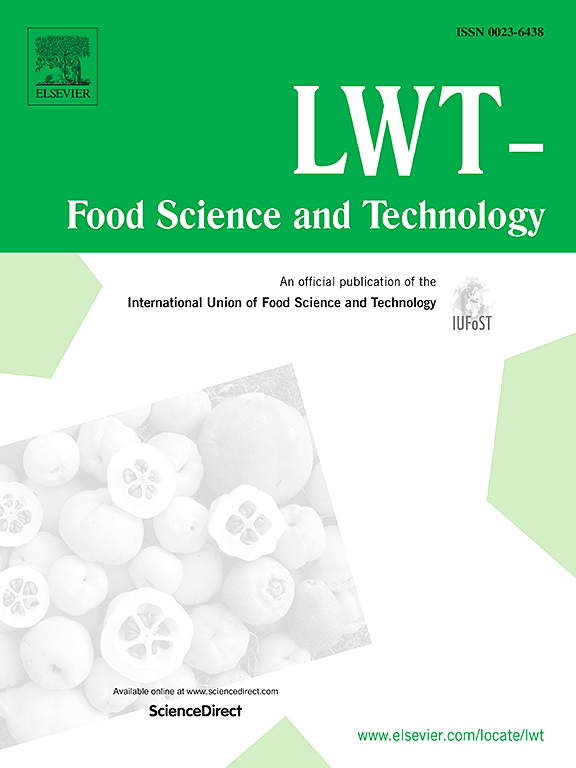Ultrasound-assisted extraction, optimization, purification of gallic acid from walnut green husk and analysis of their antioxidant and antibacterial properties
IF 6
1区 农林科学
Q1 FOOD SCIENCE & TECHNOLOGY
引用次数: 0
Abstract
The walnut green husk (WGH), a byproduct of food industry processing, is often discarded as waste. This study presents a comprehensive and efficient approach for the extraction, purification, and characterization of gallic acid (GA) from WGH. Using response surface methodology (RSM), optimal extraction conditions were determined, achieving a GA yield of 15.585 % under the following parameters: ethanol volume fraction of 73 %, solid-liquid ratio of 1:30 g/mL, ultrasonic temperature of 65 °C, and ultrasonic time of 43 min. GA was further purified through macroporous resin adsorption, with ADS-17 exhibiting the highest adsorption capacity. Under optimal conditions, the adsorption capacity reached 0.89 mg/g, desorption efficiency was 75 %, and GA purity was 83.07 %. Compared with the crude extract of gallic acid (CEGA) and a pure GA standard solution, the purified extract of gallic acid (PEGA) showed significantly increased antioxidant activity. The scavenging efficiency of DPPH· and ABTS·+ free radicals increased linearly with GA concentration. PEGA also demonstrated potent antibacterial activity against Staphylococcus aureus (S. aureus), Escherichia coli (E. coli), and Candida albicans (C. albicans). These findings highlight the potential of GA extracted from WGH as a natural antioxidant and antimicrobial agent for applications in the food industry.
超声辅助提取、优化、纯化核桃青皮没食子酸及其抗氧化、抗菌性能分析
核桃绿壳是食品工业加工的副产品,常被作为废物丢弃。本研究提出了一种全面、高效的从白羊草中提取、纯化和表征没食子酸(GA)的方法。在乙醇体积分数为73%、料液比为1:30 g/mL、超声温度为65℃、超声时间为43 min的条件下,利用响应面法(RSM)确定了最佳提取条件,GA得率为15.585%。通过大孔树脂吸附对GA进行进一步纯化,ADS-17吸附量最大。在最佳条件下,吸附量为0.89 mg/g,解吸效率为75%,GA纯度为83.07%。与没食子酸粗提物(CEGA)和没食子酸纯标准液相比,没食子酸纯提物(PEGA)的抗氧化活性显著提高。对DPPH·和ABTS·+自由基的清除率随GA浓度的增加呈线性增加。PEGA还显示出对金黄色葡萄球菌(S. aureus)、大肠杆菌(E. coli)和白色念珠菌(C.白色念珠菌)的有效抗菌活性。这些发现突出了从白桦茸中提取的GA作为天然抗氧化剂和抗菌剂在食品工业中的应用潜力。
本文章由计算机程序翻译,如有差异,请以英文原文为准。
求助全文
约1分钟内获得全文
求助全文
来源期刊

LWT - Food Science and Technology
工程技术-食品科技
CiteScore
11.80
自引率
6.70%
发文量
1724
审稿时长
65 days
期刊介绍:
LWT - Food Science and Technology is an international journal that publishes innovative papers in the fields of food chemistry, biochemistry, microbiology, technology and nutrition. The work described should be innovative either in the approach or in the methods used. The significance of the results either for the science community or for the food industry must also be specified. Contributions written in English are welcomed in the form of review articles, short reviews, research papers, and research notes. Papers featuring animal trials and cell cultures are outside the scope of the journal and will not be considered for publication.
 求助内容:
求助内容: 应助结果提醒方式:
应助结果提醒方式:


